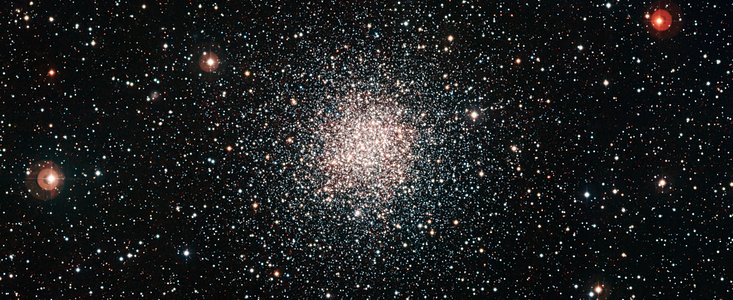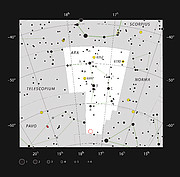Press Release
Stars Ancient and Modern?
31 October 2012
This colourful view of the globular star cluster NGC 6362 was captured by the Wide Field Imager attached to the MPG/ESO 2.2-metre telescope at ESO’s La Silla Observatory in Chile. This new picture, along with a new image of the central region from the NASA/ESA Hubble Space Telescope, provide the best view of this little-known cluster ever obtained. Globular clusters are mainly composed of tens of thousands of very ancient stars, but they also contain some stars that look suspiciously young.
Globular star clusters are among the oldest objects in the Universe, and NGC 6362 cannot hide its age in this picture. The many yellowish stars in the cluster have already run through much of their lives and become red giant stars. But globular clusters are not static relics from the past — some curious stellar activities are still going on in these dense star cities.
For instance, NGC 6362 is home to many blue stragglers — old stars that really do succeed in passing for a younger age. All of the stars in a globular cluster formed over a fairly short period of time, typically about 10 billion years ago for most globulars. Yet blue stragglers are bluer and more luminous — and hence more massive — than they should be after ten billion years of stellar evolution. Blue stars are hot and consume their fuel quickly, so if these stars had formed about ten billion years ago, then they should have fizzled out long ago. How did they survive?
Astronomers are keen to understand the secret of the youthful appearance of blue stragglers. Currently, there are two main theories: stars colliding and merging, and a transfer of material between two companion stars. The basic idea behind both of these options is that the stars were not born as big as we see them today, but that they received an injection of extra material at some point during their lifetimes and this then gave them a new lease of life.
Although less well known than some brighter globular clusters, NGC 6362 holds much that is of interest to astronomers and has been well studied over the years. It was selected as one of the 160 stellar fields for the Pre-FLAMES Survey — a preliminary survey conducted between 1999 and 2002 using the 2.2-metre telescope at La Silla to find suitable stars for follow-up observations with the VLT’s spectroscopic instrument FLAMES. The picture here comes from data collected as part of this survey.
The new image shows the entire cluster against a rich background of the carpet of stars in the Milky Way. The central parts of NGC 6362 have also been studied in detail by the NASA/ESA Hubble Space Telescope. The Hubble view shows a much smaller area of sky in much greater detail. The two views — one wide-angle and one zoomed in — complement each other perfectly.
This brilliant ball of stars lies in the southern constellation of Ara (The Altar). It can be easily seen in a small telescope. It was first spotted in 1826 by the Scottish astronomer James Dunlop using a 22-centimetre telescope in Australia.
More information
The year 2012 marks the 50th anniversary of the founding of the European Southern Observatory (ESO). ESO is the foremost intergovernmental astronomy organisation in Europe and the world’s most productive astronomical observatory. It is supported by 15 countries: Austria, Belgium, Brazil, Czechia, Denmark, France, Finland, Germany, Italy, the Netherlands, Portugal, Spain, Sweden, Switzerland and the United Kingdom. ESO carries out an ambitious programme focused on the design, construction and operation of powerful ground-based observing facilities enabling astronomers to make important scientific discoveries. ESO also plays a leading role in promoting and organising cooperation in astronomical research. ESO operates three unique world-class observing sites in Chile: La Silla, Paranal and Chajnantor. At Paranal, ESO operates the Very Large Telescope, the world’s most advanced visible-light astronomical observatory and two survey telescopes. VISTA works in the infrared and is the world’s largest survey telescope and the VLT Survey Telescope is the largest telescope designed to exclusively survey the skies in visible light. ESO is the European partner of a revolutionary astronomical telescope ALMA, the largest astronomical project in existence. ESO is currently planning the 39-metre European Extremely Large optical/near-infrared Telescope, the E-ELT, which will become “the world’s biggest eye on the sky”.
Links
- Photos of the MPG/ESO 2.2-metre telescope
- Other photos taken with the MPG/ESO 2.2-metre telescope
- Photos of La Silla
Contacts
Richard Hook
ESO, La Silla, Paranal, E-ELT and Survey Telescopes Public Information Officer
Garching bei München, Germany
Tel: +49 89 3200 6655
Cell: +49 151 1537 3591
Email: rhook@eso.org
About the Release
| Release No.: | eso1243 |
| Name: | NGC 6362 |
| Type: | Milky Way : Star : Grouping : Cluster : Globular |
| Facility: | MPG/ESO 2.2-metre telescope |
| Instruments: | WFI |








